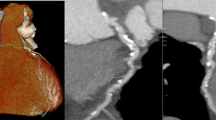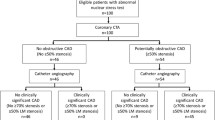Abstract
Purpose
The authors sought to evaluate the incremental value of introducing coronary angiography with multidetector computed tomography (MDCT-CA) compared with the conventional diagnostic workup in managing patients with suspected coronary artery disease (CAD) workup.
Materials and methods
A total of 531 consecutive patients underwent MDCT-CA between April 2008 and August 2010. For each patient the pretest probability of CAD was obtained by using the Morise score as well as the diagnostic performance of the exercise test and of MDCT-CA, considering conventional coronary angiography (CCA) as the gold standard. Based on these results, we calculated the posttest likelihood of CAD after stress testing, comparing the incremental diagnostic value for each category of cardiovascular risk with data obtained with MDCT-CA. The conventional diagnostic workup (without MDCT-CA) was then compared with the modified workup (including MDCT-CA).
Results
The diagnostic performance of the exercise test for identifying patients with significant lesions had a sensitivity and specificity of 20% and 88%, respectively, with positive (PPV) and negative (NPV) predictive value of 41% and 72%, respectively. Taking CA as the gold standard, MDCT-CA had 93% sensitivity, 89% specificity, 88% PPV and 93% NPV compared with CCA in evaluating significant stenoses in the per-patient analysis. The overall diagnostic accuracy of MDCT-CA was 91%. The exercise tests provided no significant incremental diagnostic value compared with cardiovascular history in patients with a low to intermediate risk. Comparison of the diagnostic accuracy of these protocols showed improved performance results for the modified protocol.
Conclusions
MDCT-CA is the reference modality for the noninvasive exclusion of critical CAD. It provides a very high incremental diagnostic value compared with exercise testing in patients with a low to intermediate risk of CAD. The use of diagnostic protocols based on MDCT-CA ensures improved diagnostic performance compared with those involving conventional exercise electrocardiograms.
Riassunto
Obiettivo
Scopo del nostro lavoro è valutare il valore incrementale dell’introduzione della angiografia coronarica mediante tomografia assiale multistrato (AC-TCMS) nella gestione diagnostica del paziente con sospetta malattia coronarica (CAD) rispetto al tradizionale workup diagnostico.
Materiali e metodi
Sono stati presi in considerazione 531 pazienti consecutivi sottoposti ad AC-TCMS tra marzo 2008 e agosto 2010. Per ogni paziente è stato calcolata la probabilità pre-test di CAD mediante Morise score e la performance diagnostica del cicloergometro e della ACTCMS considerando l’AC come standard di riferimento; Sulla base dei risultati è stata calcolata la probabilità post-test di CAD dopo stress test, confrontandone il valore diagnostico incrementale per ogni categoria di rischio cardiovascolare con i dati ottenuti dalla AC-TCMS. è stato confrontato il percorso diagnostico tradizionale senza ACTCMS, con quello modificato dall’introduzione dell’ACTCMS.
Risultati
La performance diagnostica dello stress test nella individuazione dei pazienti con lesioni significative ha dimostrato una sensibilità e specificità del 20% e 88% con valore predittivo positivo (VPP) e valore predittivo negativo (VPN) di 41% e 72%. Considerando come standard di riferimento la AC il confronto tra AC e ACTCMS nella valutazione di stenosi significative mediante analisi per paziente ha rilevato una sensibilità pari a 93%, una specificità pari a 89%, un VPP e VPN pari a 88 % e 93%. L’accuratezza diagnostica globale della metodica è risultata essere pari a 91%. Lo stress test ha dimostrato di non fornire un significativo valore diagnostico incrementale rispetto all’anamnesi cardiovascolare nei pazienti a basso-medio rischio. Il confronto tra l’accuratezza diagnostica dei protocolli ha dimostrato una migliore performance del protocollo che prevede l’introduzione dell’ACTCMS nei confronti del protocollo tradizionale.
Conclusioni
La AC-TCMS è una metodica di riferimento non invasiva per l’esclusione di coronaropatia critica. Fornisce un valore diagnostico incrementale molto elevato rispetto allo stress test nei pazienti a basso-medio rischio. L’utilizzazione del protocollo diagnostico che prevede l’utilizzo dell’AC-TCMS garantisce una migliore perfomance diagnostica rispetto al protocollo tradizionale.
Similar content being viewed by others
References/Bibliografia
Cademartiri F, Aldrovandi A, Palumbo A et al (2007) Multislice computed tomography coronary angiography: clinical applications. Minerva Cardioangiol 55:647–658
Cademartiri F, La Grutta L, Palumbo A et al (2007) Non-invasive visualization of coronary atherosclerosis: state-of-art. J Cardiovasc Med (Hagerstown) 8:129–137
Cademartiri F, La Grutta L, Palumbo AA et al (2006) Coronary plaque imaging with multislice computed tomography: technique and clinical applications. Eur Radiol 16Suppl 7:M44–M53
Cademartiri F, Maffei E, Notarangelo F et al (2008) 64-slice computed tomography coronary angiography: diagnostic accuracy in the real world. Radiol Med 113:163–180
Cademartiri F, Maffei E, Palumbo A et al (2007) Diagnostic accuracy of 64-slice computed tomography coronary angiography in patients with low-to-intermediate risk. Radiol Med 112:969–981
Achenbach S, Giesler T, Ropers D et al (2001) Detection of coronary artery stenoses by contrast-enhanced, retrospectively electrocardiographically-gated, multislice spiral computed tomography. Circulation 103:2535–2538
Achenbach S, Ulzheimer S, Baum U et al (2000) Noninvasive coronary angiography by retrospectively ECG-gated multislice spiral CT. Circulation 102:2823–2828
Schroeder S, Achenbach S, Bengel F et al (2008) Cardiac computed tomography: indications, applications, limitations, and training requirements: report of a Writing Group deployed by the Working Group Nuclear Cardiology and Cardiac CT of the European Society of Cardiology and the European Council of Nuclear Cardiology. Eur Heart J 29:531–556
Achenbach S, Ropers D, Kuettner A et al (2006) Contrast-enhanced coronary artery visualization by dualsource computed tomography—initial experience. Eur J Radiol 57:331–335
Ropers D, Baum U, Pohle K et al (2003) Detection of coronary artery stenoses with thin-slice multi-detector row spiral computed tomography and multiplanar reconstruction. Circulation 107:664–666
Cademartiri F, Maffei E, Mollet NR (2008) Is dual-source CT coronary angiography ready for the real world? Eur Heart J 29:701–703
Maffei E, Palumbo A, Martini C et al (2010) Stress-ECG vs. CT coronary angiography for the diagnosis of coronary artery disease: a “real-world” experience. Radiol Med 115:354–367
Hendel RC, Patel MR, Kramer CM, et al (2006) ACCF/ACR/SCCT/ SCMR/ASNC/NASCI/SCAI/SIR 2006 appropriateness criteria for cardiac computed tomography and cardiac magnetic resonance imaging: a report of the American College of Cardiology Foundation Quality Strategic Directions Committee Appropriateness Criteria Working Group, American College of Radiology, Society of Cardiovascular Computed Tomography, Society for Cardiovascular Magnetic Resonance, American Society of Nuclear Cardiology, North American Society for Cardiac Imaging, Society for Cardiovascular Angiography and Interventions, and Society of Interventional Radiology. J Am Coll Cardiol 48:1475–1497
Cademartiri F, La Grutta L, Palumbo A et al (2009) Computed tomography coronary angiography vs. stress ECG in patients with stable angina. Radiol Med 114:513–523
Morise AP, Detrano R, Bobbio M, Diamond GA (1992) Development and validation of a logistic regressionderived algorithm for estimating the incremental probability of coronary artery disease before and after exercise testing. J Am Coll Cardiol 20:1187–1196
Lipinski M, Do D, Froelicher V et al (2001) Comparison of exercise test scores and physician estimation in determining disease probability. Arch Intern Med 161:2239–2244
Cademartiri F, Luccichenti G, Gualerzi M et al (2005) Intravenous contrast material administration in multislice computed tomography coronary angiography. Acta Biomed 76:86–94
Malago R, D’Onofrio M, Baglio I et al (2009) Choice strategy of different dose-saving protocols in 64-slice MDCT coronary angiography. Radiol Med 114:1196–1213
Maffei E, Martini C, De Crescenzo S et al (2010) Low dose CT of the heart: a quantum leap into a new era of cardiovascular imaging. Radiol Med 115:1179–1207
Hamoir XL, Flohr T, Hamoir V et al (2005) Coronary arteries: assessment of image quality and optimal reconstruction window in retrospective ECG-gated multislice CT at 375-ms gantry rotation time. Eur Radiol 15:296–304
Leschka S, Scheffel H, Desbiolles L et al (2007) Image quality and reconstruction intervals of dualsource CT coronary angiography: recommendations for ECG-pulsing windowing. Invest Radiol 42:543–549
Detre KM, Wright E, Murphy ML, Takaro T (1975) Observer agreement in evaluating coronary angiograms. Circulation 52:979–986
Nieman K, Cademartiri F, Lemos PA et al (2002) Reliable noninvasive coronary angiography with fast submillimeter multislice spiral computed tomography. Circulation 106:2051–2054
Aldrovandi A, Maffei E, Palumbo A et al (2009) Prognostic value of computed tomography coronary angiography in patients with suspected coronary artery disease: a 24-month follow-up study. Eur Radiol 19:1653–1660
Cademartiri F, Luccichenti G, Marano R et al (2003) Non-invasive angiography of the coronary arteries with multislice computed tomography: state of the art and future prospects. Radiol Med 106:284–296
Cademartiri F, Maffei E, Palumbo A et al (2010) Diagnostic accuracy of computed tomography coronary angiography in patients with a zero calcium score. Eur Radiol 20:81–87
Budoff MJ, Cohen MC, Garcia MJ et al (2005) ACCF/AHA clinical competence statement on cardiac imaging with computed tomography and magnetic resonance. Circulation 112:598–617
Dewey M, Dubel HP, Schink T et al (2007) Head-to-head comparison of multislice computed tomography and exercise electrocardiography for diagnosis of coronary artery disease. Eur Heart J 28:2485–2490
Author information
Authors and Affiliations
Corresponding author
Rights and permissions
About this article
Cite this article
Malagò, R., Pezzato, A., Barbiani, C. et al. Role of coronary angiography MDCT in the clinical setting: changes in diagnostic workup in the real world. Radiol med 117, 939–952 (2012). https://doi.org/10.1007/s11547-012-0842-6
Received:
Accepted:
Published:
Issue Date:
DOI: https://doi.org/10.1007/s11547-012-0842-6




